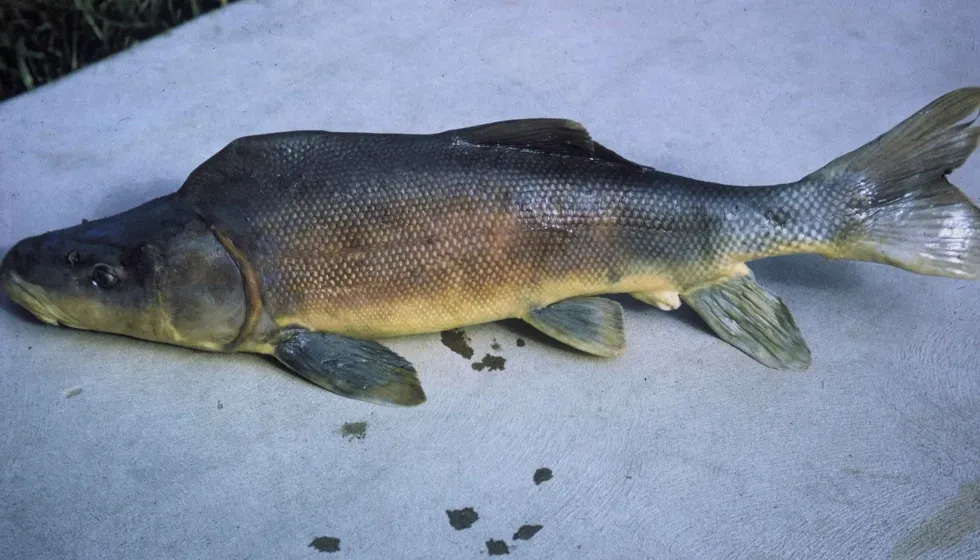What strikes your mind when you consider living in a river or a lake? Shrimp, lobster, and of course fish.
Of the innumerable varieties of fish, the Razorback sucker would interest you. Known by its scientific name Xyrauchen Texanus, these incredible species stand out from other Catastomids with two of their exceptional features, a well-defined ridge that stretches out from its head to the dorsal fin and its drawn-out filaments on the gill rakers.
This bulge on its back gives its common name razorback sucker or humpback sucker.
The razorback sucker (Xyrauchen Texanus) is a migratory species that live in freshwater sources. The Colorado River, the Green River, the Yampa River, Lake Mead, and Lake Mohave are some of the prominent water bodies that house this fish species.
They migrate to and from the river system and the lake for depositing eggs. However, due to critical habitat loss and the construction of dams and canals, the population of the fish has considerably reduced, making them a critically endangered species.
Let's embark on a fascinating expedition ahead and be well-informed about this unique creature. If this article interests you, you would surely like catfish facts and dogfish facts too.
Razorback Sucker Interesting Facts
What type of animal is a Razorback Sucker?
The razorback sucker is one of the largest warm-water fish species in North America. This fish is primarily found in the Colorado River basin in the southwestern part of the United States.
What class of animal does a Razorback Sucker belong to?
The razorback suckerfish is one of the largest suckerfish in North America. It is a native fish of the Colorado River. It belongs to the class Actinopterygii. This endangered species is a unique and intriguing creature that is known for its peculiar hump.
How many Razorback Suckers are there in the world?
The exact population of razorback sucker fish remains unknown. However, due to environmental factors, there is a steep decline in their number, making them Critically Endangered.
There are efforts to re-establish the population of razorbacks in the Green River and Colorado River systems through stocking programs. Also, managing non-native fish and the population of predators has helped in restoration to a certain extent.
Where does a Razorback Sucker live?
Razorback suckers are warm-water fish found in freshwater rivers and lakes of the southwestern United States.
What is a Razorback Sucker's habitat?
Initially, the razorback sucker was widespread across the Colorado River and its major tributaries in the Colorado River basin. The destruction of its habitat and being preyed upon by other fish species like the sunfish, carp, and trout have caused the population of the humpback sucker to fall drastically.
The distribution of the Razorback sucker has become limited to the lower basin of the Colorado River system in Lake Mead, Lake Mohave, and Lake Havasu.
The Grand Canyon in Arizona and its impoundments also find a considerable population of Razorback suckerfish.
A significant population is found in the Green River, Utah, and River Yampa in the upper Colorado River basin. Lake Mead and Lake Mohave in Arizona Nevada region also serve as significant habitats for them.
Who does Razorback Sucker live with?
The Razorback sucker generally lives in groups. The group of Razorback suckers migrates upstream from the main stem river and to the riverbeds and cobble bars in the river system for spawning. Several males attend the female Razorback sucker, which repeatedly spawns with different males.
How long does a Razorback Sucker live?
The razorback sucker (Xyrauchen texanus) is one of the long-lived suckers. They have a lifespan of more than 40 years.
How do they reproduce?
The razorback suckers reproduce by releasing their gametes in the riverbeds. Male and female species mature and reproduce at around four years of age. Several males attend to a single female, which means they are polyandrous.
Razorback adult suckers migrate to the riverbeds and cobble bars and discharge their gametes. Spawning occurs in spring or late winter, with riverbeds as spawning grounds.
The female Razorback sucker releases around 10 to 12 eggs each time and has a gestation period of about three to four weeks. The water temperature decides the success of hatching. A temperature of lower than 50 degrees F (10 degrees C) results in the death of the eggs.
What is their conservation status?
The razorback sucker was once known to be a prevalent species native to the Colorado River basin, in North America. However, there has been a drastic decline in the population of razorback suckers.
The International Union for Conservation of Nature (IUCN) Red List of Threatened Species has categorized them as Critically Endangered species.
Many factors have been attributed to the small number of species- the destruction of habitat due to the construction of dams and canals and non-native predators, which prey on the larvae. Contamination in the rivers also results in increased mortality of larvae.
Considerable recovery measures have been taken to restore the population of the species such as restoration of floodplain habitat and fish stocking. Conservation efforts are ongoing in the upper Colorado River basin. Fish stocking has supplemented razorback suckers' populations except in Lake Mead.
Razorback Sucker Fun Facts
What do Razorback Suckers look like?

The razorback sucker is clearly distinguished by the sharp-edged bulge that stretches on its anterior side. It has a long snout, a rounded head, and a mouth with a lower lip cleft. Adult razorback suckers have a peculiar predorsal keel that distinguishes them from juvenile suckers.
How cute are they?
The razorback sucker fish has a blend of various colors on its body, making it attractive. The species has a shade of olive to dark brown on the dorsal part, whereas it has a yellowish-white on the ventral side.
In addition, the male species are slightly darker dorsal parts in the breeding season, with orangish-yellow ventral sides. These colors and the sharp-edged ridge on the body make it unique looking.
How do they communicate?
Razorback suckerfish communicate in a very unique and exciting way. The fish produce flash signals using eye rolls as a means of communication.
This quick eye roll mechanism is a novel way to communicate between male suckers to announce their presence to other male suckers. Larval razorback suckers communicate in increased water flow and darkness during their downstream movements in rivers.
How big is a Razorback Sucker?
The Razorback suckerfish is one of the largest suckerfish. The length of the adult fish generally goes up to 3 ft ( 91 cm).
The female species are generally longer and more robust. The lower basin of the Colorado River is home to the largest suckers. Research in the upper Colorado river basin shows that the length of the female species suckerfish exceeds that of the male.
If you compare it to a goldfish in your fish tank, the Razorback sucker is almost six to seven times larger in length.
How fast can a Razorback Sucker run?
More research is required to understand the speed at which the razorback suckers swim. However, when it senses danger, it uses its five powerful fins to navigate swiftly through the water.
How much does a Razorback Sucker weigh?
The adult razorback sucker generally weighs up to 13.2 lb (6 kg ). The juvenile razorbacks are very tiny and have negligible weight.
What are the male and female names of the species?
There are no sex-specific names for the razorback sucker.
What would you call a baby Razorback Sucker?
They are called juveniles, larvae, or fry.
What do they eat?
The habitat, stage of the life cycle, and availability of food decide the food habits of the razorback suckers. Razorback suckers are secondary consumers and feed on algae, macro and micro invertebrates, and plankton. They also feed on larvae and decomposing plants at the river or lake beds.
Are they poisonous?
There is no proven study to claim that razorback suckers are poisonous.
Would they make a good pet?
Generally, razorback suckers are not kept as pets. They are categorized as endangered species. Their small number is a cause of concern, and measures are being taken to restore their population in the Grand Canyon and the Colorado River basin in Arizona.
Did you know...
An exciting defense feature of Razorback suckers is their sticky lips, which allow them the benefit of staying stuck to rocks and not being swept by the water current in the rivers.
Do they bite?
Studies do not confirm that razorback suckers bite.
Do humans eat them?
Native people and early settlers of North America eat these fish species. However, their primary threat is from non-native fish species like carp, trout, and sunfish that predate them.
Here at Kidadl, we have carefully created lots of interesting family-friendly animal facts for everyone to discover! Learn more about some other fish including swai fish facts and skate fish facts.
You can even occupy yourself at home by coloring in one of our free printable razorback sucker coloring pages.










